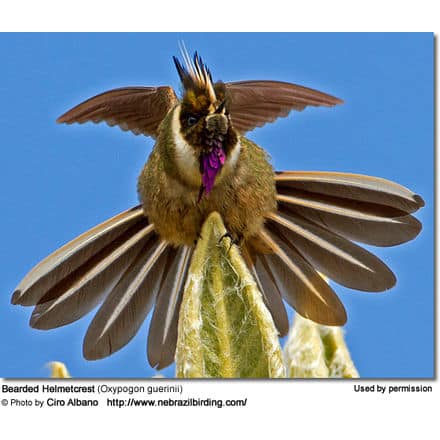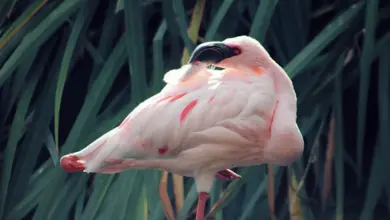Bearded Helmetcrest (Oxypogon guerinii)
Bearded Helmetcrest (Oxypogon guerinii)
Hummingbird Information
The Bearded Helmetcrests (Oxypogon guerinii) – also known as Linden’s Helmetcrests – are large hummingbirds found in the South American countries of Colombia and Venezuela.
They are related to the Bearded Mountaineer (Oreonympha nobilis) and the Rufous-capped Thornbill (Chalcostigma ruficeps).
Distribution / Range
The Bearded Helmetcrests are native to the Andes mountain range that runs along the western coast of South America. In Venezuela, they are found at altitudes of 12,000 – 15,000 feet (3,600 – 4,500 meters) and in Colombia at 10,500 – 17,000 feet (3,200 – 5,200 meters).
Their preferred breeding habitat is the páramo – high-altitude subtropical or tropical
high-altitude grassland. After the breeding season (the dry season), they descend to the treeline. They are often seen perching on boulders.
As is typical of hummingbirds, they are mostly solitary and spend their days alone foraging in low bushes. However, during the non-breeding (dry) season, several of them may be observed.
Subspecies and Distribution
-
-
- Oxypogon guerinii guerinii (Boissonneau, 1840) – Nominate Form
- Found in the east Andes of Colombia (south to centrally located Colombian department Cundinamarca)
- Found in the east Andes of Colombia (south to centrally located Colombian department Cundinamarca)
- Oxypogon guerinii guerinii (Boissonneau, 1840) – Nominate Form
-
- Oxypogon guerinii cyanolaemus (Salvin and Godman, 1880)
- Found in northeastern Colombia (Santa Marta, department of Magdalena)
- Oxypogon guerinii cyanolaemus (Salvin and Godman, 1880)
-
- Oxypogon guerinii lindenii (Parzudaki, 1845)
- Found in the Andes of northwestern Venezuela in the states of Mérida and Trujillo
- Oxypogon guerinii lindenii (Parzudaki, 1845)
- Oxypogon guerinii stuebelii (A. B. Meyer, 1884)
- Found in central Colombia – in the region of the Nevado del Ruiz (La Mesa de Herveo) – a volcano located on the border of the departments of Caldas and Tolima
-
Description
Bearded Helmetcrests are easily identified by the long, pointed crests and black and white beards. The face is black except for a blue, green or orange central stripe. There is a pale collar around the face down to the chest.
Alternate (Global) Names:
Chinese: ??? … Czech: Kolibrík prilbový … Danish: Hjelmkolibri … Dutch: Helmkolibrie … Finnish: Kypäräkolibri … French: Colibri casqué, Colibri casqué de Guérin … German: Helmkolibri … Italian: Barbacresta, Colibrì dall’elmo di Guerin … Japanese: herumettohachidori … Norwegian: Hjelmkolibri … Polish: helmik, he?mik, He?mik d?ugobrody … Russian: ????????? ???????-??????????, ??????????? ??????? … Slovak: vrchárik bradatý … Spanish: Barbudito Paramuno, Chivito de los Páramos, Colibrí Chivito … Swedish: Hjälmkolibri
Nesting / Breeding
Bearded Helmetcrest Hummingbirds breed during the rainy season. During this time, males sing continuously as they seek to attract females.
The male’s only involvement in the reproductive process is the actual mating with the female. They neither live nor migrate in flocks; and there is no pair bond for this species. Males court females by flying in a u-shaped pattern in front of them. He will separate from the female immediately after copulation. One male may mate with several females. In all likelihood, the female will also mate with several males. The males do not participate in choosing the nest location, building the nest or raising the chicks.
The female is responsible for building the cup-shaped nest out of plant fibers woven together and green moss on the outside for camouflage in a protected location in the daisy Espeletia or builds a nest of material from the daisy plant in a cliff or bank.
She lines the nest with soft plant fibers, animal hair and feather down, and strengthens the structure with spider webbing and other sticky material, giving it an elastic quality to allow it to stretch to double its size as the chicks grow and need more room. The nest is typically found on a low, skinny horizontal branch.
The average clutch consists of two white eggs, which she incubates alone, while the male defends his territory and the flowers he feeds on. The young are born blind, immobile and without any down.
The female alone protects and feeds the chicks with regurgitated food (mostly partially-digested insects since nectar is an insufficient source of protein for the growing chicks). The female pushes the food down the chicks’ throats with her long bill directly into their stomachs.
As is the case with other hummingbird species, the chicks are brooded only the first week or two, and left alone even on
cooler nights after about 12 days – probably due to the small nest size. The chicks leave the nest when they are about 20 days old.
Diet / Feeding
The Bearded Helmetcrest Hummingbirds primarily feed on nectar taken from a variety of brightly colored, scented small flowers of trees, herbs, shrubs and epiphytes. They favor the flowers of the genera Espeletia, Echeveria, Siphocampylus, Castilleja and Draba. They use their long, extendible, straw-like tongues to retrieve the nectar while hovering with their tails cocked upward as they are licking at the nectar up to 13 times per second. Sometimes they may be seen hanging on the flower while feeding.
They also take some small spiders and insects – important sources of protein particularly needed during the breeding season to ensure the proper development of their young. Insects are often caught in flight (hawking); snatched off leaves or branches, or are taken from spider webs. A nesting female can capture up to 2,000 insects a day.
When foraging, they typically cling onto flowers or sometimes walk on the ground as they search for insects.
Males establish feeding territories, where they aggressively chase away other males as well as large insects – such as bumblebees and hawk moths – that want to feed in their territory. They use aerial flights and intimidating displays to defend their territories.
Metabolism and Survival and Flight Adaptions – Amazing Facts
Other Relevant Web Resources
Species Research by Sibylle Johnson
Please Note: The articles or images on this page are the sole property of the authors or photographers. Please contact them directly with respect to any copyright or licensing questions. Thank you.









